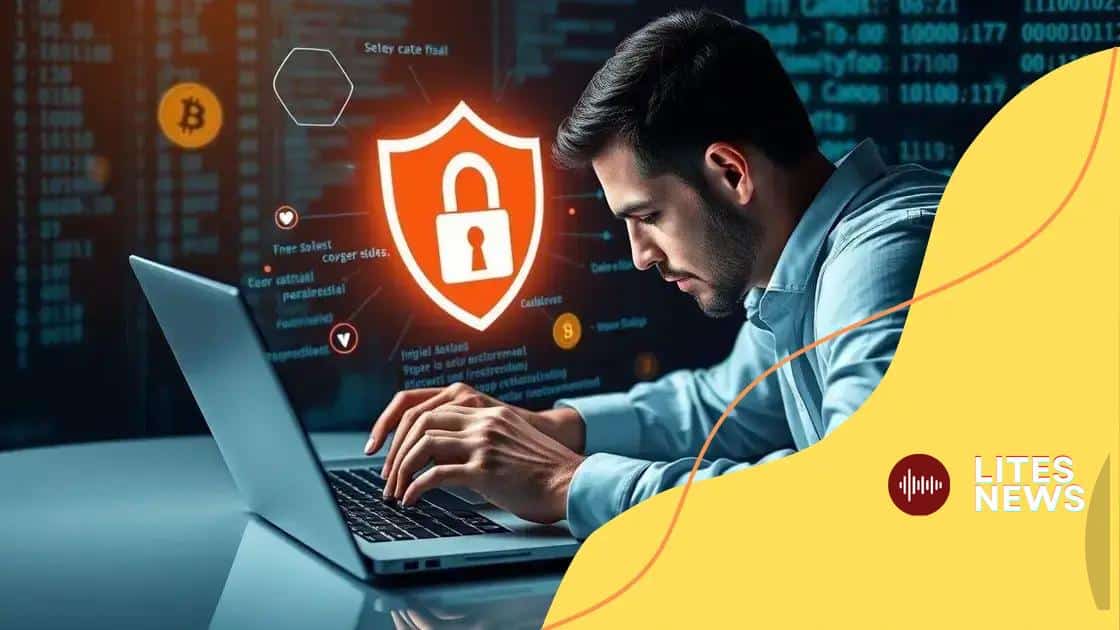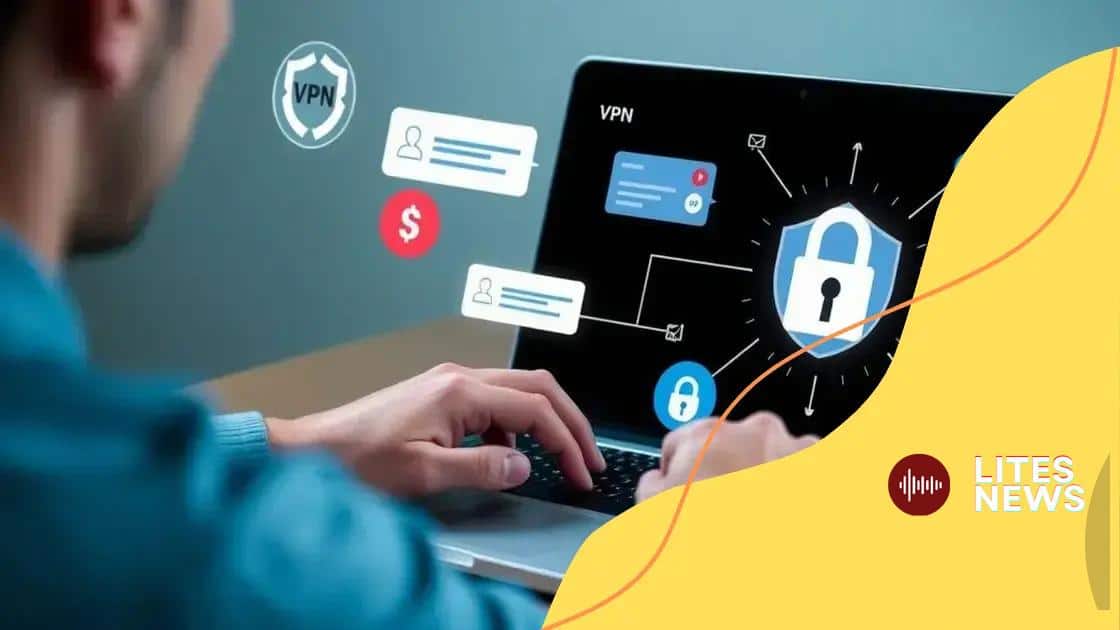Cryptocurrency security best practices for safer investments

Implementing cryptocurrency security best practices, such as two-factor authentication, software updates, and awareness of phishing threats, is essential to safeguarding your digital assets from unauthorized access and cyberattacks.
When it comes to protecting your investments, cryptocurrency security best practices are more crucial than ever. With rising cyber threats, how can you ensure your digital assets remain safe? Let’s dive into some effective strategies.
Understanding cryptocurrency threats
Understanding cryptocurrency threats is fundamental for anyone engaging in digital currencies. The world of cryptocurrency is exciting but comes with unique risks.
Many users are unaware of the various threats that can impact their digital investments. Let’s explore some of the most common risks associated with cryptocurrency and how they can affect your assets.
Types of Threats
Several key threats can compromise your cryptocurrency security. It’s important to stay informed about these risks to protect your investments.
- Phishing attacks: Cybercriminals often use phishing to deceive users into giving up their private keys or account details.
- Malware: Some malicious software can steal your cryptocurrency from your wallet or device.
- Exchange hacks: Cryptocurrency exchanges can be targeted, leading to theft of users’ funds.
- Ransomware: Attackers may lock your files and demand payment in cryptocurrency.
Additionally, social engineering plays a significant role in these threats. Users must be cautious of unsolicited messages or offers claiming to help them gain wealth quickly. Always verify the source before clicking on links or sharing information.
Staying Vigilant
To stay safe, be proactive about your security measures. Use strong, unique passwords for your accounts and enable two-factor authentication wherever possible.
Regularly monitor your accounts for any unauthorized activity. This vigilant approach can help you quickly detect issues before they escalate. Remember, the responsibility of protecting your cryptocurrency wallet ultimately falls on you.
As the cryptocurrency landscape evolves, new threats will emerge. Keeping up with the latest security news can equip you with knowledge and strategies to counteract these threats effectively. Stay informed and always prioritize your digital security.
Best practices for wallet security
Ensuring wallet security is essential for protecting your cryptocurrency assets. A compromised wallet can lead to significant financial loss. Therefore, it’s vital to understand the best practices for securing your digital wallet.
Create Strong Passwords
The first line of defense is a strong password. Use a combination of uppercase and lowercase letters, numbers, and symbols. Avoid common words or predictable phrases.
Additionally, consider using a password manager to generate and store complex passwords securely. This tool will help you maintain unique passwords for various accounts, reducing the risk of breaches.
Enable Two-Factor Authentication
Two-factor authentication (2FA) adds an extra layer of security. By requiring a second form of identification, such as a verification code sent to your phone, it becomes much harder for unauthorized users to access your wallet.
- Use an authentication app: Apps like Google Authenticator provide a secure way to generate 2FA codes.
- Do not rely solely on SMS: Text messages can be intercepted. Opt for app-based authentication instead.
- Regularly review your 2FA settings: Ensure that your 2FA is active and functioning properly.
Ultimately, a little diligence goes a long way in keeping your wallet secure. Avoid sharing your private keys or recovery phrases with anyone. These pieces of information are essential in accessing your funds.
Keep Wallet Software Updated
Regular updates to your wallet software are crucial. Developers frequently release updates that patch security vulnerabilities. Ensuring you have the latest version protects you from known threats.
Stay informed about your wallet’s community and forums. Engaging with other users can provide insights into emerging threats and security tips. The more knowledge you have, the better equipped you are to fend off potential attacks.
Safeguarding transactions and communications

Safeguarding transactions and communications is crucial in the world of cryptocurrency. Each transaction carries risks, so it’s essential to implement measures that protect your financial data.
Ensuring that your transactions are secure can help prevent unauthorized access to your funds. It’s also important to keep your communication methods secure, especially when discussing sensitive information.
Use Secure Networks
Always conduct transactions over secure and trusted networks. Public Wi-Fi can pose security risks, making your data vulnerable to hackers. Instead, use a Virtual Private Network (VPN) when accessing sensitive accounts.
- Connect to secure Wi-Fi: Ensure that your home or office network is encrypted with a strong password.
- Avoid public networks: Do not perform transactions on unsecured public Wi-Fi.
- Utilize VPNs: A VPN encrypts your internet data, adding an additional layer of privacy.
Proper use of secure networks is only the start. Additionally, be mindful of the tools you use for transactions, as some platforms have better security measures than others.
Encrypt Your Communications
When discussing cryptocurrency transactions or sharing wallet information, communication should always be encrypted. Use encrypted messaging apps that offer end-to-end encryption, ensuring that your messages are only readable by the intended recipients.
Never share sensitive information over email or unencrypted platforms. If you need to share information, consider using secure file-sharing services that encrypt data.
By taking these precautions, you can significantly reduce the likelihood of your transactions or communication being intercepted by malicious actors. Always remain vigilant in monitoring your accounts for any suspicious activities.
The role of two-factor authentication
The role of two-factor authentication (2FA) in securing cryptocurrency accounts cannot be overstated. It adds a critical layer of protection that significantly reduces the risk of unauthorized access.
When you enable 2FA, logging into your account requires not just your password but also another verification method, making it much harder for hackers to succeed.
How 2FA Works
2FA works by requiring two types of information to verify your identity. The first step is something you know, such as your password. The second step is something you have, like a code sent to your phone or generated by an app.
This dual requirement greatly enhances security. Here are some methods typically used:
- SMS Verification: A code is sent to your mobile device via text message.
- Authentication Apps: Apps like Google Authenticator or Authy generate time-sensitive codes.
- Hardware Tokens: Physical devices that generate unique login codes.
While SMS is common, be aware that it can be less secure than app-based methods. Always strive to use an authentication app for better security.
Benefits of Using 2FA
Utilizing two-factor authentication brings numerous advantages. First, it drastically lowers the chances of someone accessing your account even if they have your password. Second, it can alert you to suspicious activities. If you receive a code request that you did not initiate, it’s a clear indicator that your account may be compromised.
Finally, many platforms offer a seamless setup process for 2FA, making it easy and quick to enhance your security. Establishing these extra security measures can provide peace of mind when managing your cryptocurrency assets.
Keeping software and systems updated
Keeping software and systems updated is a crucial aspect of maintaining security in the world of cryptocurrency. Regular updates help to protect against vulnerabilities that hackers can exploit.
When you use outdated versions of software, you expose yourself to risks that may have already been addressed in newer releases. This is especially true for cryptocurrency wallets, exchanges, and operating systems.
Why Updates Matter
Updates often include important security patches that fix known issues. Cyber threats are constantly evolving, and developers work hard to stay ahead by offering updates that enhance security features.
Here are some reasons to prioritize updates:
- Vulnerability Fixes: Updating software reduces the chances of an attack by closing security gaps.
- New Features: Many updates come with improved functionalities that can enhance user experience and security.
- Performance Enhancements: Updates often improve the performance and efficiency of the software.
By ignoring updates, you not only risk your own assets but also potentially expose others in your network to attacks.
Establishing a Routine
To avoid missing updates, establish a routine for checking and installing them. Many software programs allow automatic updates. Enabling this feature can simplify the process.
Additionally, regularly review the settings on your devices, wallets, and apps to ensure that they are up to date. Keeping track of update notifications is also beneficial. By being proactive, you safeguard your cryptocurrency investments against potential threats.
FAQ – Frequently Asked Questions about Cryptocurrency Security
What is two-factor authentication (2FA)?
Two-factor authentication (2FA) is a security process that requires two different forms of identification to access an account, adding an extra layer of protection.
Why is keeping software updated important for security?
Keeping software updated is important because updates often include security patches that fix vulnerabilities, protecting against potential attacks from hackers.
How can I recognize phishing attempts?
You can recognize phishing attempts by looking for suspicious emails or messages that ask for personal information or direct you to unfamiliar websites.
What are some best practices for securing my cryptocurrency holdings?
Best practices include using strong passwords, enabling two-factor authentication, keeping your software updated, and being cautious about sharing personal information.





